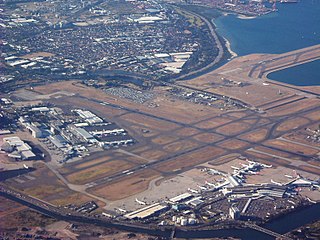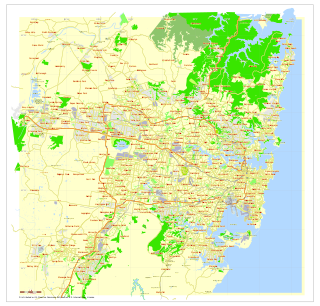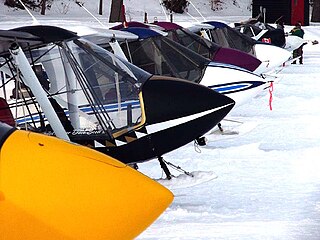
An airport is an aerodrome with extended facilities, mostly for commercial air transport. Airports often have facilities to store and maintain aircraft, and a control tower. An airport consists of a landing area, which comprises an aerially accessible open space including at least one operationally active surface such as a runway for a plane to take off or a helipad, and often includes adjacent utility buildings such as control towers, hangars and terminals. Larger airports may have airport aprons, taxiway bridges, air traffic control centres, passenger facilities such as restaurants and lounges, and emergency services. In some countries, the US in particular, they also typically have one or more fixed-base operators, serving general aviation.

Sydney Airport is an international airport in Sydney, Australia located 8 km (5 mi) south of Sydney city centre, in the suburb of Mascot. The airport is owned by the ASX-listed Sydney Airport Group. It is the primary airport serving Sydney, and is a primary hub for Qantas, as well as a secondary hub for Virgin Australia and Jetstar Airways. Situated next to Botany Bay, the airport has three runways, colloquially known as the east–west, north–south and third runways.

Essendon Fields Airport, colloquially known as Essendon Airport, is a 305 ha public airport serving scheduled commercial, corporate-jet, charter and general aviation flights. It is located next to the intersection of the Tullamarine and Calder Freeways, in the north western suburb of Essendon Fields of Melbourne, Victoria, Australia. The airport is the closest to Melbourne's City Centre, approximately a 13 km (8.1 mi) drive north-west from it and 8 km (5.0 mi) south-east from Melbourne Tullamarine Airport. In 1970, Tullamarine Airport replaced Essendon as Melbourne's main airport.

Bendigo Airport, is located in East Bendigo just north of Bendigo, Victoria, Australia, just off the Midland Highway. The airport is about 10 minutes drive from the CBD of Bendigo.

Bathurst Airport is an airport serving Bathurst, New South Wales, Australia.

Moree Airport is an airport in Moree, New South Wales, Australia. The airport is 5 km (3.1 mi) from the city center. The airport has some scheduled services but mainly provides general aviation facilities, maintenance and support for agricultural aviation in the local area. The Moree Aero Club has been based at the airport since 1952, and today provides aircraft hire and flight training. The club was instrumental in providing many early improvements to the aerodrome facilities, including hangars and a terminal building.

Illawarra Regional Airport or Wollongong Airport is an airport located in Albion Park Rail, 18 km (11 mi) southwest of Wollongong, New South Wales, Australia. The Historical Aircraft Restoration Society (HARS) is located at the airport. The airline Fly Corporate offers daily services from the airport to Melbourne–Essendon and Brisbane.

Advance Airlines Flight DR4210 was a scheduled passenger flight which crashed at Sydney Airport on 21 February 1980, killing all 13 people on board the Advance Airlines Beech Beechcraft King Air 200. After taking off on runway 25 for a scheduled flight the aircraft's left (port) engine failed and the pilot requested an emergency landing on runway 34. The plane crashed into the sea wall while attempting the emergency landing. The accident caused the greatest number of fatalities in a civil aircraft crash in Australia since MacRobertson Miller Airlines Flight 1750, a Vickers Viscount that crashed near Port Hedland in Western Australia on 31 December 1968 killing all 26 on board.

Temora Airport is a small airport located 2 nautical miles northwest of Temora, New South Wales, Australia. Currently no regularly scheduled passenger fights serve the airport. The current owner, the Temora Shire Council do not charge landing fees for aircraft to use the facility, encouraging a wide variety of general aviation uses, including skydiving, gliding, flight training, kit aircraft assembly and aircraft maintenance. It is also the home of the Temora Aviation Museum and hosts regularly flying displays and events.

Tumut Airport is a small airport in Tumut, New South Wales, Australia. The airport was constructed during the 1960s, replacing an earlier airfield known as Butler's Field on a nearby private property. The airport caters mostly to general aviation and recreational category aircraft, and is located within two hours flying time of both Sydney and Melbourne, half an hour from Canberra and within minutes of Wagga Wagga Airport offering major aircraft maintenance facilities.

Scone Airport, is a public airport in the Upper Hunter Valley, 4 km (2.5 mi) northwest of Scone, Australia. It was built to provide a public aerodrome replacing Nandowra aerodrome on located on "Nandowra", approx. 9 km south of Scone.

West Auckland Airport Parakai West Auckland Airport is a general aviation (GA) airfield on the North Western edge of Auckland, New Zealand, within the Auckland City Local body area. It is close to the town of Parakai and 2 nautical miles northwest of Helensville at the southern end of the Kaipara Harbour.

Lethbridge Airpark is a privately owned aerodrome located 6 km (3.7 mi) north of the rural township of Lethbridge between the regional cities of Geelong 35 km (22 mi) to the south and Ballarat 50 km (31 mi) to the north in Victoria, Australia. The 80 ha site caters to private and recreational pilots, and offers flight training. Current facilities at the airport include several hangars, an aircraft maintenance workshop, and basic amenities including toilets and showers.

Emkaytee Airfield, also known as MKT Airfield is a private airport near Noonamah, Northern Territory, Australia and approximately 40 km (25 mi) south of the city of Darwin. The airfield has been operated by the Meyering family since 1980. Predominately used for recreational flying by ultralight aircraft, Emkaytee also provides flight training, aircraft maintenance and fuel supplies. The airfield has been used by the Australian Army, Royal Australian Air Force, customs and emergency services as a training and staging facility. Based on aircraft movements Emkaytee is the Northern Territory's second busiest after Darwin International Airport and provides an alternative destination for visiting light aircraft.

Maitland Airport, also known as Russell Field is a general aviation airport located in the suburb of Rutherford, approximately 5 km (3.1 mi) from Maitland in the Australian state of New South Wales. There are currently no airline services, with the airfield catering mostly to general aviation and recreational category aircraft. The airport has been owned and operated by the Royal Newcastle Aero Club since 1963 and shares a large training area with the nearby Cessnock Airport. Throughout its history, the airport has played host to many airshows, races and flying competitions. The field is named for the fifth President of the Royal Newcastle Aero Club, Robert Russell, who suffered a fatal heart attack while on the premises in 1966.

Cooma–Polo Flat Airport is an unlicensed airfield located in Polo Flat, an industrial area of Cooma, New South Wales, Australia. The airfield is used primarily for recreational flying. Polo Flat is at a lower elevation than the nearby Cooma–Snowy Mountains Airport and is less prone to closure during bad weather and fog.

The Oaks Airfield is an unlicensed private airfield located in The Oaks, New South Wales in the Wollondilly Shire, west of Sydney Australia. Originally built by the Royal Australian Air Force (RAAF) during World War II, today the airfield caters mostly to recreational aircraft and flight training and is home to Dave's Flying School and the Sydney Recreational Flying Club. The airfield is a heritage listed site and is the only airport constructed during WWII to still be operational. Other airfields from the time in Sydney have either being converted or demolished,

Caboolture Airfield is an aerodrome catering to general aviation and ultralight aircraft located in Caboolture, Queensland, approximately 55 km (34 mi) north of the state capital Brisbane, adjacent to the Bruce Highway. The airfield is maintained and operated by the Caboolture Aero Club Incorporated and shares a large training area with nearby Caloundra Airport and Redcliffe Airport. The airfield is a popular site for the restoration of historic aircraft and a number of associated businesses are located onsite.

Somersby Airfield is an Australian airfield located in the town of Somersby, New South Wales. The airport is 12 kilometres (7.5 mi) by road from the Central Business District of the nearby city of Gosford, and is one of the closest airports to it. It is the only aerodrome in Somersby, and does not serve scheduled commercial traffic.























